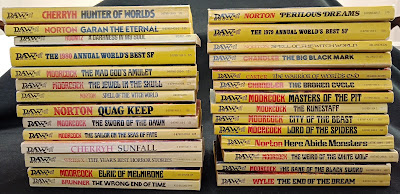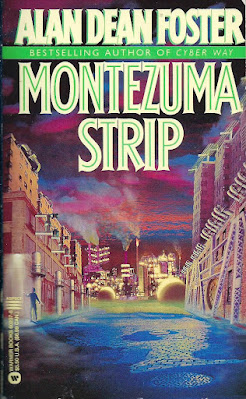Book Review: 'Tower of Dreams' by Jamil Nasir
'Tower of Dreams' (231 pp.) was published by Bantam Spectra in January 1999. It's one of six science fiction and fantasy novels author Nasir has published between 1995 and 2013. My review of his 1995 novel 'Quasar' is here.
'Tower' is set some 25 or so years into the 21st century. Blaine Ramsey, the protagonist, is an 'Image digger,' one of a select group of people with the ability to enter into a dreamlike state and receive imagery being fabricated by the collective unconscious of the surrounding populace. The use of meditative techniques and special herbs allows the digger to retain images encountered in dreams, and archive them into computers. The saved images can be used by multinational corporations for advertising and marketing campaigns. The more unorthodox an image, the more valued it is to the corporations.
As the novel opens, Ramsey is working for a prominent West Coast firm called Icon. He's been dispatched to a rural area in Jordan, there to dig into the surrounding Arab culture for new and provocative images. While engaged in his reveries, Ramsey has a particularly vivid dream about Buthaina, a beautiful Arab girl who lives in the home adjacent to his. However idyllic the start of his dream, it ends in tragedy when the girl is brutally beaten by her father.
Ramsey becomes obsessed with Buthaina, not only convinced that she is a real human being, but that he can rescue her. Ramsey arranges to travel to Cairo, where he hopes to learn more about Buthaina's true identity and hopefully, her whereabouts.
This near-future Cairo is a nightmarish place; Egypt has a population of 100 million, 35 million of whom live in the city. Stuffed into crumbling buildings and breathing dangerously polluted air, the vast majority of the populace are overwhelmed by poverty:
Beggars suddenly swarmed around the car, hanging on the windows on both sides with their dirty hands, entreating in broken English and French, trying to catch Blaine's eye, reaching into the car to clutch at him. Many were children or women holding babies. They made room for a security policeman to approach the car but otherwise ignored him. For the first time since coming to Cairo Blaine felt suddenly afraid of them, of the starving, homeless, desperate people in their hordes upon hordes. He rolled up the taxi windows with difficulty, almost catching a few insistent fingers in the glass, feeling guilty, angry, and a little sick, as he guessed visiting foreigners - it was only a courtesy to call them 'tourists' anymore - felt.
Ramsey's search takes him from the slums to the glittering nightclubs and high-rise apartment buildings of the city's wealthy elite. But his search is constrained by ominous events: debilitating visions of Buthaina come to Ramsey in his waking hours, and the visions coincide with alarming indications that a catastrophic earthquake looms for Egypt. Increasingly, the quest to find Buthaina requires a willingness to risk loss of life or limb. But Ramsey is too far gone in his obsession to think about stopping..........
I won't
disclose spoilers about the denouement of the novel, but it involves a
kind of 'Arab Magic Realism' that, for me, was unsatisfying and led me
to award the book four, rather than five, Stars.
While the word 'cyberpunk' appears neither in the book nor in any of the advertising blurbs, I believe 'Tower' to be a second-generation cyberpunk novel. It's the book's cyberpunk aspects, and its Middle Eastern / Arab / Muslim setting, that give 'Tower' its offbeat quality. In this regard it is something of a spiritual successor to the 'Budayeen' novels of George Alec Effinger. But Nasir, who is the son of a Palestinian father and an American mother, has an inherent familiarity with the culture of the society he writes about that Effinger did not have. This familiarity gives the book a powerful verisimilitude.
Summing up, readers looking for a cyberpunk novel that eschews the traditional First World, or East Asian, locales and characters will find that 'Tower of Dreams' offer something new and imaginative.


















































